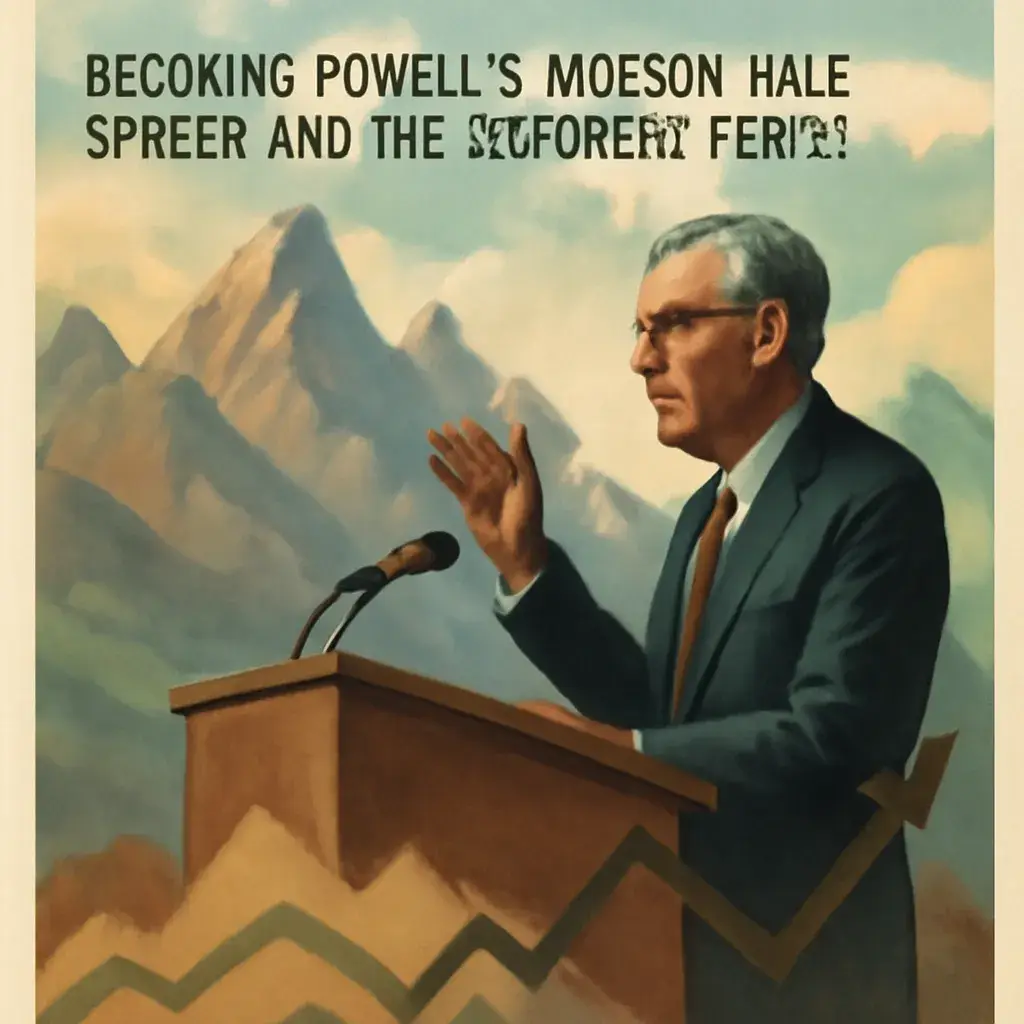
I remember the first time I followed the Jackson Hole Economic Policy Symposium—it was less about fiscal theory and more about the drama: mountain backdrops, cryptic statements, and a sense that everything mattered just a bit more. This year, with the Fed Chair’s words carrying extra weight, I tuned in again, coffee in hand, anticipating any hints about what might come next. Here’s what stood out from Jerome Powell’s latest address and why you might want to pay attention, even if economics isn’t your first love.
The High Altitude Stage: Why Jackson Hole Matters
I’ve covered dozens of Federal Reserve meetings over the years, but nothing quite compares to the anticipation that builds around the Jackson Hole Symposium. On August 22, 2025, I found myself once again making the pilgrimage to Jackson Lake Lodge in Grand Teton National Park, where the world’s most powerful central bankers gather against one of America’s most breathtaking backdrops.
There’s something almost theatrical about holding the Economic Policy Symposium 2025 in this setting. The towering peaks of the Teton Range seem to mirror the high stakes of monetary policy decisions that ripple across global markets. This isn’t just another conference room filled with economists—it’s the epicenter of global central bank discourse, where casual conversations over coffee can move billions of dollars.
A Tradition That Moves Markets
Since 1982, the Jackson Hole Economic Policy Symposium has served as the unofficial launching pad for major policy shifts. I’ve witnessed firsthand how a single phrase from this stage can send markets into a frenzy or calm volatile trading sessions. As former Cleveland Fed President Loretta Mester once told me:
“The annual Jackson Hole Symposium is where monetary policy plans get their trial run before the public.”
This year felt different from the moment I arrived at Jackson Lake Lodge. The usual buzz of speculation was electric with anticipation of a potential Fed pivot. Every conversation seemed to circle back to one question: would Powell signal the long-awaited shift toward rate cuts?
The Room Where It Happens
Walking through the lodge’s rustic halls, I couldn’t help but marvel at the cast of characters assembling for this Federal Reserve meeting. Global central bankers, Nobel Prize-winning economists, financial journalists, and policy wonks—all converging on this remote Wyoming outpost. The guest list reads like a who’s who of monetary policy, each attendee hanging on every nuanced word that might hint at the Fed’s next move.
I must admit, I’ve developed my own “Jackson Hole bingo” over the years, expecting at least one hiking metaphor in every major speech. Powell didn’t disappoint this time around—though the metaphors felt more urgent, more loaded with meaning than in previous years.
High Stakes at High Altitude
What makes Jackson Hole particularly fascinating is how the remote setting strips away the usual Washington D.C. formalities. Here, surrounded by wilderness, central bankers seem more willing to speak candidly about their concerns and intentions. The informal breakfast conversations and evening receptions often yield as much insight as the formal presentations.
This year’s symposium carried an unusual weight of expectation. With markets already pricing in potential rate cuts and employment data showing concerning trends, Powell’s speech wasn’t just another policy address—it was a moment that could define the Fed’s trajectory through 2025 and beyond.
The mountain air seemed to amplify every word, every pause, every carefully chosen phrase that would soon echo through trading floors from New York to Tokyo.

Powell’s Speech: Reading Between the Lines (and the Lines Themselves)
I once tried summarizing a Fed speech for friends in one sentence. Their eyes glazed over within seconds. This time, when Jerome Powell delivered his Jackson Hole speech, his hint about downside job risks kept everyone alert—even my non-economist friends.
The Art of Fed-Speak: “Leaning Toward” Big Changes
The Federal Reserve Chair chose his words carefully at Jackson Lake Lodge, but one phrase stood out: the Fed is “leaning toward” rate cuts. In Fed-speak, this isn’t casual language—it’s a signal flare. When Jerome Powell uses such direct phrasing, markets listen. And they did, with stock indexes rallying and bond yields dipping immediately after his remarks.
Powell’s most telling moment came with this statement:
“The risks to maximum employment are beginning to outweigh those from inflation.”
This wasn’t just policy commentary—it was a fundamental shift in thinking. The Jerome Powell Jackson Hole speech essentially announced that unemployment worries now rival inflation concerns in the Fed’s decision-making process.
Employment Takes Center Stage
For months, inflation dominated Fed discussions. Now, Fed Chair Jerome Powell remarks suggest the labor market deserves equal attention. Recent data shows unemployment ticking upward, while inflation has cooled from its post-pandemic highs. This dual pressure creates the perfect storm for a Federal Reserve rate cut September meeting.
The timing isn’t coincidental. Markets widely anticipate a September rate cut aligned with Powell’s signals, with most expecting a 0.25% reduction at the upcoming FOMC meeting.
The Framework Revolution
Beyond rate cut hints, Powell introduced something unusual: a new Statement on Longer-Run Goals. This updated framework signals how the Fed plans to balance its dual mandate moving forward. It’s rare for the Fed to revise its strategic approach during a speech, making this move particularly significant.
The framework overhaul suggests deeper changes ahead—not just in rates, but in how the Fed thinks about economic policy entirely.
Reading the Unspoken
Market-watchers dissected not only Powell’s words, but his pauses, inflections, and even his tie color (navy, if you were curious). This level of scrutiny might seem excessive, but Fed communications move trillions in market value.
Powell’s approach was masterful—no wild overpromises, but an unmistakable underlying tone: rate relief may be coming soon. He danced around specifics while making his intentions crystal clear to those who know how to listen.
The speech occurred against a backdrop of political tensions, with pressures from various quarters adding context to Powell’s careful messaging. Yet he maintained the Fed’s traditional independence while signaling policy flexibility.
What struck me most was Powell’s balance between caution and clarity. He flagged employment risks without creating panic, suggested rate cuts without making promises, and updated the Fed’s framework without dramatic fanfare. It was Fed communication at its finest—saying everything without saying too much.
3. Markets Get the Message—And React in Real Time
Watching markets respond to Powell’s Jackson Hole speech felt like witnessing a perfectly choreographed dance between monetary policy and financial sentiment. Within minutes of his address, U.S. stock indexes broke into a rally that would make any trader’s heart race—a vivid market endorsement of his messaging about potential rate cuts ahead.
The Immediate Market Reaction Powell Speech August Delivered
The numbers tell the story better than any analysis could. Stock indexes surged across the board, with the S&P 500, Dow, and Nasdaq all posting solid gains as investors digested Powell’s dovish tone. Meanwhile, bond yields slipped lower as traders priced in expectations for looser monetary policy. The 10-year Treasury yield dropped noticeably, signaling that bond markets were buying into the Fed’s potential pivot.
I’ll admit, watching this unfold reminded me of a costly lesson from years past. I once lost a lunch bet by confidently predicting markets would shrug off Fed news as “already priced in.” Never again—Powell’s words still move mountains (and billions of dollars).
Dollar Response Fed Policy Shifts Create Ripple Effects
The dollar’s response was equally telling. The dollar index softened against major currencies as Powell’s remarks sparked expectations that U.S. interest rates might soon head lower. Currency traders know that rate cut speculation typically weakens a currency, and they positioned accordingly almost instantly.
“Every word from Powell can mean a million-dollar swing,” noted Mohamed El-Erian, capturing the outsized influence central bankers wield over global markets.
Real-Time Sentiment Tracking
What struck me most was how some traders were tracking social media sentiment by the hour, hunting for ‘Powell bounce’ hashtags and parsing every financial journalist’s immediate take. The speed at which information travels and translates into trading positions has transformed market dynamics completely.
Financial Twitter exploded with commentary moments after the speech concluded. Professional traders, retail investors, and financial media personalities all weighed in, creating a real-time feedback loop that amplified the market’s initial reaction.
The Sports Event Phenomenon
Honestly, it felt almost like watching a live sports event—the excitement (or anxiety) was instantly measurable through price movements. Every tick higher in stock futures or lower in bond yields represented millions of dollars changing hands based on Powell’s carefully chosen words.
The quick moves in markets reinforce just how thirsty investors remain for Fed clues. After months of mixed signals and economic uncertainty, traders jumped at any hint of policy direction from Jackson Hole.
Beyond the Initial Reaction
These immediate shifts in stocks, bonds, and foreign exchange markets reflect Powell’s real-time influence on financial sentiment. The market reaction wasn’t just about the content of his speech—it was about the collective interpretation that September rate cuts had become more likely.
The synchronized movement across asset classes demonstrated how deeply interconnected global markets have become, with Powell’s mountain-top address creating waves that rippled through every major financial center within hours.

4. The Fed’s Framework Gets a Tune-Up: Redefining the Dual Mandate
The Federal Reserve just rolled out something bigger than another rate decision—they’ve updated their entire playbook. The new Statement on Longer-Run Goals represents the most significant monetary policy framework review we’ve seen in years, and it’s reshaping how the Fed thinks about their core mission.
Why Fix What Wasn’t Broken?
Here’s the thing about the Federal Reserve dual mandate—it’s been around since the 1970s, tasking the Fed with juggling maximum employment and price stability. Think of it like spinning plates, except these plates control whether millions of Americans have jobs and can afford groceries.
But why tweak the framework after all these decades? Because the economy’s shape is fundamentally changing. We’re dealing with post-pandemic volatility, shifting job trends, and economic dynamics that would make your grandfather’s Fed chairman dizzy. The old rigid approach needed an upgrade.
The New Rules of the Game
Powell’s framework update suggests something crucial: flexibility over rigidity. Instead of fixating on specific inflation thresholds like a hawk watching prey, the Fed is embracing context and broader economic dynamics Federal Reserve strategy considerations.
Labor market metrics are now incorporated more dynamically. Rather than relying solely on fixed inflation numbers, the Fed is scanning the horizon for employment turbulence too. It’s a more holistic approach—like upgrading from cable TV to streaming. You’re still watching your favorite shows (implementing monetary policy), but now you have more control over the outcome.
“A flexible framework is vital as the economy grows more complex.” – Janet Yellen
What This Means for Fed Policy Changes
The big implication? This isn’t just about reacting to inflation employment data anymore. The Fed is acknowledging an increasingly unpredictable economic environment where traditional metrics might not tell the full story.
Consider this: the labor market remains near maximum employment, yet unemployment has recently increased. Under the old framework, this mixed signal might have caused policy paralysis. The new approach allows for more nuanced responses.
Real-World Impact
This framework overhaul delivers a refreshed view of how the Fed navigates its dual mandate amid evolving economic realities. Instead of mechanical responses to data points, we’re seeing adaptive policy-making that considers:
- Post-pandemic economic scarring
- Changing labor force participation patterns
- Supply chain disruption effects
- Technology’s impact on traditional employment metrics
The Fed’s revised Statement on Longer-Run Goals in 2025 reflects this shift toward adaptability. It’s acknowledgment that the economic landscape has fundamentally changed, and monetary policy needs to evolve accordingly.
This framework tune-up isn’t just bureaucratic paperwork—it’s the Fed admitting that the old playbook needs updating for a more complex economic reality. As Powell emphasized during his Jackson Hole speech, the focus on downside risks to employment alongside ongoing inflation concerns shows this new flexible approach in action.
5. Politics in the Peaks: Navigating Tensions and the Weight of Words
Behind Powell’s measured economic analysis at Jackson Lake Lodge, I witnessed something that felt more like political theater than monetary policy. The Fed Chair’s speech carried weight beyond mere interest rate signals—it was a careful dance around the growing political tensions impact that now shadow every Federal Reserve decision.
Presidential Pressure and Central Bank Independence
The Trump administration’s vocal demands for rate cuts have created an unusually charged atmosphere around Fed policy. I’ve covered enough Fed meetings to know that Powell’s language yesterday went beyond typical economic messaging. Every phrase seemed calibrated not just for markets, but for political ears.
This isn’t your grandfather’s Fed communication strategy. Powell’s emphasis on central bank independence felt deliberate and pointed. When he discussed the Fed’s dual mandate, I heard an underlying message: We make policy based on data, not politics.
The New Fed Pressure Cooker
Congressional scrutiny has intensified beyond traditional oversight. Social media storms now follow every Fed statement, creating what I can only describe as a “pressure cooker” environment. Political tensions impact Fed policy in ways we haven’t seen in decades.
“There’s more shouting outside than inside these halls,” Fed Vice Chair Michael Barr allegedly muttered, capturing the surreal nature of today’s monetary policy landscape.
This observation rings true. The cacophony of political voices demanding action—or inaction—has reached fever pitch. I watched Powell navigate these crosscurrents with the precision of a chess master, where every word carries multiple meanings.
Financial Markets Pressure Meets Political Reality
The market rally following Powell’s speech tells only part of the story. Yes, stocks jumped and bond yields fell, but the real story lies in how financial markets pressure now intersects with political demands. Powell must satisfy both Wall Street’s expectations and Washington’s political calculus.
This dual pressure creates a fascinating dynamic. I noticed how Powell’s careful language acknowledged downside employment risks—a signal to markets—while simultaneously asserting the Fed’s analytical independence—a message to politicians.
Election Year Calculations
Looking ahead to 2024, these political tensions impact Fed messaging will likely intensify. Powell’s Jackson Hole speech felt like preparation for an election cycle where monetary policy becomes a campaign issue.
The Fed’s new Statement on Longer-Run Goals, released alongside Powell’s remarks, reads like an attempt to establish clear guardrails around political interference. It’s a framework designed to weather political storms while maintaining policy credibility.
What struck me most about yesterday’s speech wasn’t just the economic content—it was watching a central banker assert institutional independence while acknowledging political reality. Powell’s words carried the weight of defending not just current policy, but the Fed’s future autonomy.
This tension between political pressure and central bank independence will likely define Fed communications through 2025 and beyond. Every speech, every statement becomes both economic signal and political positioning.

6. Looking Forward: What to Watch as 2025 Unfolds
The September Federal Open Market Committee meeting is now circled on every trader’s calendar. After Powell’s Jackson Hole speech, I’m seeing market expectations pointing toward a 0.25% rate cut with over 70% probability. But here’s what I’ve learned covering the Fed: never count on certainty when it comes to interest rate forecasts.
The September Fed Meeting: Rate Cut or Surprise?
Markets are betting heavily on a Federal Reserve rate cut September decision. The signals from Jackson Hole were clear enough—Powell emphasized employment risks while acknowledging inflation progress. Yet I’m keeping my expectations tempered. Powell has pivoted unexpectedly before, and economic data between now and September could completely reshape the narrative.
The key wild card? Labor market data. If unemployment suddenly reverses course or job growth accelerates beyond expectations, the Fed could slam the brakes on cuts faster than traders can blink.
Federal Open Market Committee Meetings: What’s Really at Stake
I’m watching three critical factors heading into Federal Open Market Committee meetings through 2025:
- Employment data releases – Any surprises here could derail rate cut expectations
- Inflation trends – Core PCE needs to stay on its downward trajectory
- Market volatility – Financial conditions could force the Fed’s hand earlier than planned
“Don’t underestimate the power of a well-timed Fed pivot.” – Neel Kashkari
This quote captures exactly what I’m thinking about 2025. The Fed’s timing will determine whether they’re seen as proactive or reactive to economic shifts.
The New Framework: A Global Game Changer
Powell’s economic outlook framework review represents more than just internal Fed policy adjustments. I believe this evolved approach to the dual mandate could become the new global standard. Other central banks are watching closely, especially as they grapple with their own post-pandemic economic puzzles.
The framework emphasizes flexibility over rigid rules—something that could prove crucial as 2025 unfolds with its unpredictable economic dynamics.
Market Volatility: Buckle Up
Here’s my honest assessment: expect ongoing market swings as traders dissect every word from future Fed communications. The rally following Jackson Hole shows how sensitive markets remain to Fed signals. Bond yields, stock indexes, and currency movements will continue reacting to the slightest policy hints.
Financial markets have priced in rate cuts, but I’m concerned about what happens if the Fed delivers less than expected or takes a more hawkish stance than anticipated.
My September Reminder
I’m setting a reminder for the September FOMC decision—and I suggest you do the same. Whether the Fed delivers the expected quarter-point cut or surprises with a different approach, that meeting will likely set the tone for monetary policy through the rest of 2025.
The economic data between now and then will tell the real story. I’ll be watching employment reports, inflation readings, and any shifts in financial conditions that might influence the Fed’s next move.
7. Conclusion: From Mountain Peaks to Your Pocketbook
Standing against the backdrop of the Grand Tetons at Jackson Lake Lodge, Jerome Powell delivered more than just another monetary policy address on August 22. His words from those mountain peaks rippled through global markets instantly—stocks rallied, bond yields dipped, and the dollar weakened as investors decoded his carefully crafted message about the Fed’s shifting stance toward rate cuts.
Powell’s Jackson Hole speech is about more than interest rates—it’s a barometer for market confidence and the Fed’s credibility. When he emphasized downside risks to employment while acknowledging ongoing inflation and employment risks, markets heard a clear signal that September rate cuts are increasingly likely. This represents a fundamental shift in the Fed’s economic outlook, moving from aggressive tightening to cautious easing.
The Real-World Impact of Fed Policy Changes
As policymakers weigh inflation against jobs in an election year, every word echoes across markets and into everyday finances. The new Statement on Longer-Run Goals isn’t just bureaucratic paperwork—it’s a roadmap for how your mortgage rates, savings accounts, and investment portfolios will be affected. The Fed’s refreshed approach to its price stability mandate signals that ongoing adaptation will define central bank policy well beyond 2025.
The market’s immediate reaction tells the story. When U.S. stock indexes surge and bond yields fall in response to a Fed chair’s speech, it’s not abstract economic theory—it’s real money moving based on expectations of easier borrowing conditions ahead. For everyday Americans, this could mean lower mortgage rates, reduced borrowing costs, but potentially lower returns on savings.
Navigating Political Pressures and Policy Precision
The backdrop of political tensions from the Trump administration and internal scrutiny adds another layer to Powell’s messaging strategy. His careful balance between acknowledging economic risks while maintaining Fed independence demonstrates the delicate dance central bankers must perform in charged political environments.
“The Fed’s job is never done, especially on the trail between risk and reward,” as former Fed official Robert Kaplan once noted.
This wisdom rings especially true as we head toward the September Federal Open Market Committee meeting. Fed policy changes don’t happen in isolation—they reflect complex calculations about employment, inflation, market stability, and political realities.
Looking Ahead: Patience and Preparation
Stay alert: The next moves from the Fed may test patience, strategy, and even your investment portfolio resolve. The Fed’s evolving approach blends economic pragmatism with strategic communication, and 2025 will likely serve as a textbook example of central banks navigating highly charged, rapidly shifting environments.
Powell’s Jackson Hole address closes with an eye on future Fed moves and real-world implications for policy, markets, and personal finance. Whether you’re planning major purchases, adjusting investment strategies, or simply trying to understand how monetary policy affects your daily life, the path from Jackson Hole’s mountain peaks leads directly to your pocketbook.
I’ll be watching the September meeting, with my hiking boots ready—and perhaps a bit more humility about market predictions.
TL;DR: Powell’s Jackson Hole speech signals a possible September rate cut, driven by shifting risk priorities and persistent political pressure. Expect continued market volatility and an evolving Fed strategy as we head into 2025.